I remember the first tangle of cotton cord on my living room floor and how calming the rhythm of knots felt as the afternoon light shifted. Making Boho Macrame Plant Hanger Tutorials became a weekend ritual for me, a little pause that turned empty corners into green, swaying moments.
These Boho Macrame Plant Hanger Tutorials are a friendly way to bring texture and life into a room.
Each tutorial I tried revealed small surprises — the smell of natural fiber, the soft drag of cord through my fingers, and the satisfaction of a pot cradled in woven lace.
Classic spiral knot hanger with soft movement
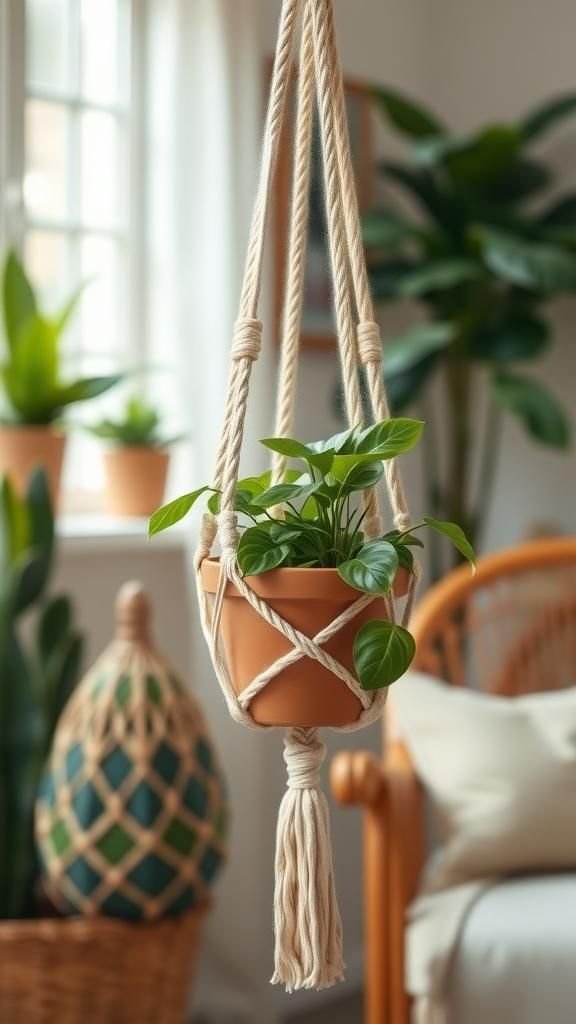
I first found myself mesmerized by the way a spiral knot twists and catches light. The cotton cord has a matte softness that makes the spiral look like a slow wave, and when a terracotta pot sits in the cradle the whole piece sways gently.
I often notice dust collecting on the inner twists in a way that highlights texture. The color of the cord changes subtly if it has been hand dyed, giving each spiral its own personality and warmth.
Steps
- Gather several equal length cords and arrange them in a radial bundle around a hanging ring.
- Create a twisted spiral by repeatedly making half knots around the central pair of cords until desired length is reached.
- Form a cradle by tying a few square knots below the spiral to secure the pot.
- Trim excess cord to tidy tassels and secure ends with a light knot near the bottom.
- Loop the top ends through a metal or wooden ring for hanging and adjust the balance so the pot sits level.
Square knot basket that cradles a planter

There is something comforting about a neat grid of square knots surrounding a pot. The pattern reads like textile lace, and I enjoy the faint rustle when a breeze moves through the leaves.
The knots press into the fingertips as the hanger is lifted, and the overall silhouette feels both sturdy and delicate. When a ceramic planter sits inside that basket the contrast between smooth glaze and fibrous cord becomes an unexpected pleasure.
A hint of sunlight brings out tiny shadows within each knot loop.
Steps
- Cut multiple lengths of cord and secure them to a ring, letting them hang evenly.
- Form a mesh around the pot area by tying alternating square knots across the cords.
- Shape the basket by drawing the mesh inward and tying gathering knots beneath the pot.
- Finish with a decorative knot or tassel beneath the gathering point to balance weight.
- Trim fringe if desired and straighten cords so the planter sits centered.
Wooden ring top with long flowing fringe
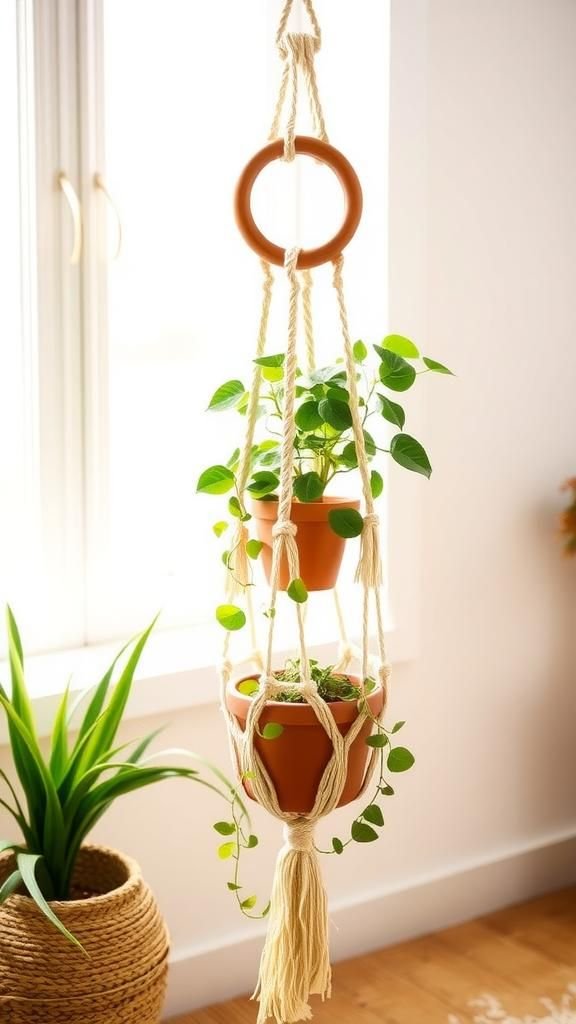
I love the interplay between smooth wood and soft cord when a wooden ring crowns a hanger. The ring feels cool under the palm and adds a handcrafted touch that anchors the piece.
The long fringe that descends from the gathering knot creates movement and a casual silhouette, catching light and tiny dust motes. When it brushes against a windowsill there is a faint whispering sound.
The wooden grain pairs well with natural jute or undyed cotton, producing a relaxed, sunwashed vibe that fits a sunny corner.
Steps
- Attach several cords to a sturdy wooden ring using lark’s head knots so they hang evenly.
- Create a loose net below the ring with alternating knots, leaving extra cord for fringe.
- Gather the cords beneath the pot area with a wrapping knot just below the planter hem.
- Allow the remaining cord to form a flowing fringe and tidy ends with even trimming.
- Hang the piece from the wooden ring and adjust the pot placement so it balances.
Beaded accents woven into natural cotton cords

Tiny wooden beads threaded along macrame cords bring an earthy rhythm that I find endlessly charming. Each bead creates a little pause in the pattern like a decorative breath, and the smoothness contrasts pleasantly with the fibrous cord.
When light hits the beads they pick up warm highlights, especially if they are amber or chestnut toned. The sound of beads nudging each other when the hanger sways is discreet and soothing, like distant rain on a tin roof.
A scattered row of beads can turn a simple hanger into something more textured and tactile.
Steps
- Slide wooden or clay beads onto selected cords before making foundational knots to position them where desired.
- Secure beads in place with small overhand knots on either side to prevent shifting.
- Continue weaving the macrame pattern, incorporating bead-adorned cords into square or spiral knots.
- Add a final bead cluster beneath the gathering knot for extra decoration if preferred.
- Inspect balance and adjust bead placement so the planter hangs evenly.
Tassel-accented hanger with layered textures

Layered tassels add a playful finish that softens the silhouette of a hanger. I often run my fingers along the tassel edge and feel the slight difference between brushed cotton and smoother cord strands.
The layered effect creates a sense of depth and invites light to settle between tiers. When placed near a window the tassels move with the air and cast gentle, shifting shadows across a nearby plant leaf.
The overall mood feels relaxed, like a well-loved textile that offers a hint of boho flair without overpowering the greenery.
Steps
- Create the main hanger structure with a ring and a supportive net of knots to hold the planter.
- Form tassels by gathering groups of cord ends where decorative tiers are desired and secure them with wrapping knots.
- Trim tassel ends to a flowing shape and separate strands for a feathery look.
- Add smaller tassel accents along the hanger length to achieve a layered appearance.
- Balance the hanger so the pot sits centrally and fluff tassels for an even silhouette.
Dyed cord variations for gentle color pops

A dip of color along the bottom portion of cord brings a subtle modern twist to an otherwise neutral hanger. I remember experimenting with gentle ombre and watching how the dye sat differently on each fiber, creating unpredictable streaks that felt organic.
The colored tips add a quiet accent when a plant grows green against them, like a small punctuation mark. Under soft light the dye appears richer, and the natural fiber still maintains that matte, tactile quality.
It feels like wearing a favorite faded scarf, familiar and slightly unexpected.
Steps
- Prepare lengths of natural cotton cord and arrange them for the hanger layout before dyeing.
- Mix a gentle fabric dye and partially immerse cord ends to achieve an ombre or dipped effect.
- Rinse dyed cords gently and allow them to dry fully before knotting to maintain color integrity.
- Assemble the hanger pattern with square or spiral knots, showcasing the dyed sections along the fringe.
- Adjust cords so the colored areas are evenly distributed around the planter for visual balance.
Double pot hanger for layered greenery display
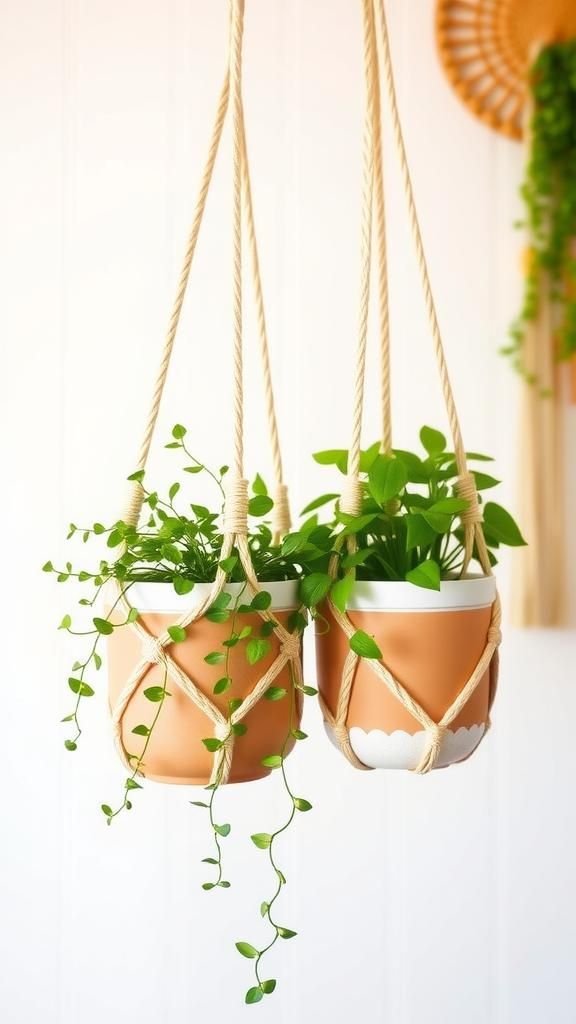
A hanger that holds two pots feels like a little vertical garden, and the staggered placement of plants creates a lively rhythm. I enjoy the way eye travels from the upper pot down to the lower, like following steps in a quiet stairway of leaves.
Different pot shapes create playful contrasts; a squat ceramic above and a tapered clay below give the arrangement personality. The cords carry the weight in a balanced geometry, and small shifts in light amplify the shadow play between the two planters, making the whole piece feel animated.
Steps
- Prepare longer cords and secure them to a strong ring to allow for dual planter heights.
- Weave a top cradle using knots sized for the upper planter and leave extra cord below for the lower cradle.
- Tie a set of gathering knots where the upper cradle ends and the lower begins to form separation.
- Create the lower cradle with a matching knot pattern sized for the second planter.
- Test balance with both planters in place and fine tune knot tension so both hang evenly.
Shelf-style macrame for small pots and decor

A woven shelf within a hanger feels like a tiny floating stage for a favorite pot or ornament. The flat surface contrasts with the roundness of most planters and gives an opportunity to pair plants with a little sculpture or candle.
Running fingers along the shelf edge reveals tightly packed fibers that hold their shape under gentle weight. Light falling across the surface highlights miniature shadow patterns made by the macrame lattice.
It creates a cozy vignette that draws attention to a single plant and elevates it in a room.
Steps
- Construct a rectangular base by weaving cords into a tight mesh that will act as the shelf platform.
- Reinforce the shelf edges by tying stronger gathering knots and adding extra cord wraps for stability.
- Attach supporting cords from each corner up to a central ring so the shelf remains level when hung.
- Position a small planter and adjust knot tension so the shelf sits flat and balanced.
- Add decorative fringe beneath the shelf if desired for a softer finish.
Triangle cradle for architectural plant display
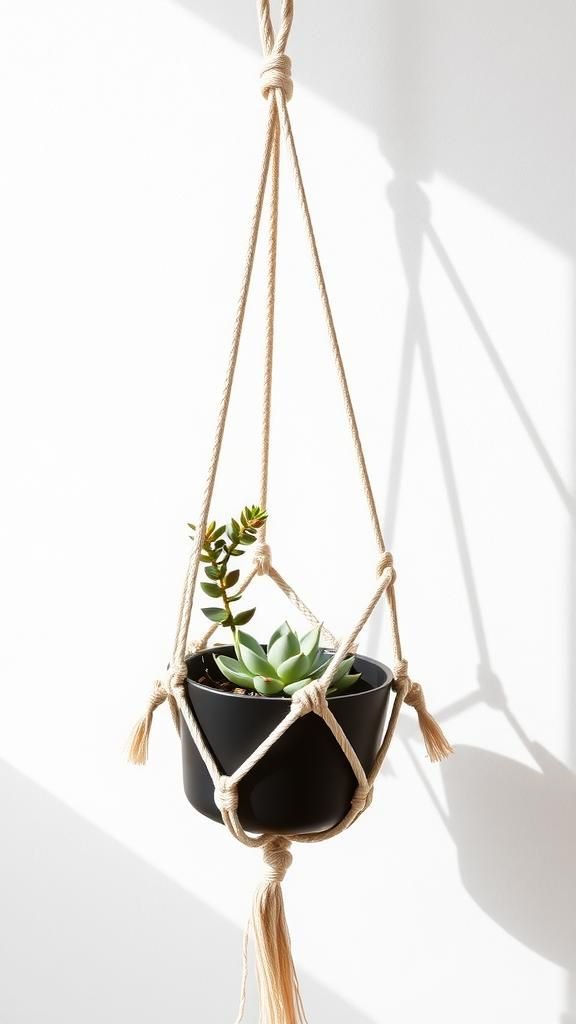
The triangular silhouette gives a hanger a graphic edge that feels modern while still cozy. When a pot nestles within those angled cords it feels like an intentional display, almost like a little sculpture.
The sharp lines contrast nicely with round leaves, producing a pleasing tension in the composition. I notice the hanger reads differently from different angles, revealing new negative spaces as I walk by.
The cord texture remains tactile and slightly warm to the touch, and overhead light casts crisp geometric shadows that move with the sun.
Steps
- Arrange cords in three evenly spaced groups and bind their tops to form a triangular apex for hanging.
- Weave each side using square or half hitch knots to create the three edges of the cradle.
- Join the three edges at the base with a secure gathering knot to form the planter seat.
- Trim and tidy the lower cords to create a neat triangular finish beneath the cradle.
- Hang the piece and adjust apex tension so the triangle remains plumb and the pot sits centered.
Coastal shell accents for seaside boho charm
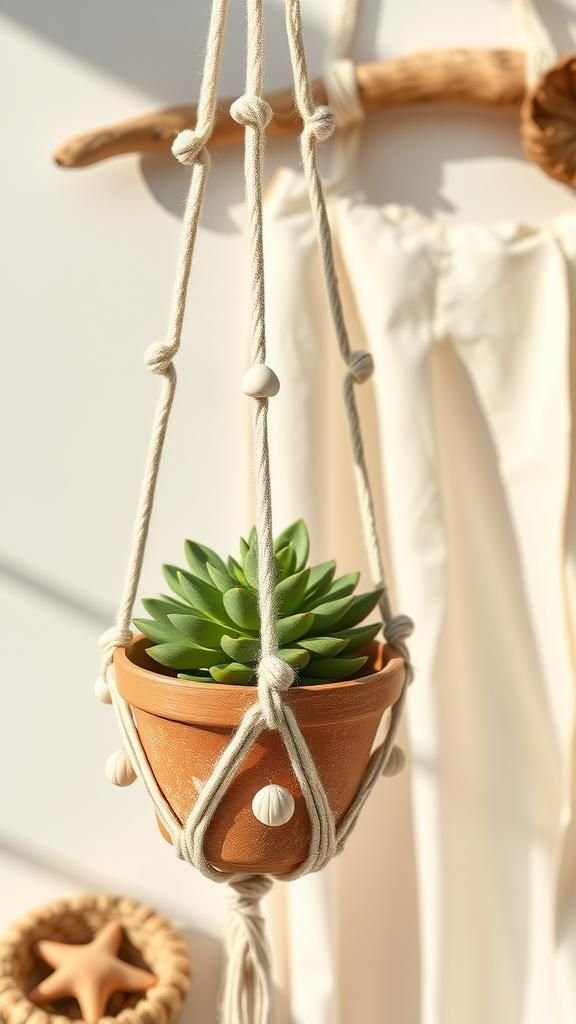
Small shells threaded into macrame create a gentle seaside whisper that I always associate with summer afternoons. The shells bring a cool, hard contrast to the soft cord, and their glossy surfaces catch stray light in tiny bright spots.
When hung near a window I imagine a faint salt breeze and the memory of walking barefoot on sand. The combination of jute or raw cotton with shells reads as relaxed and slightly weathered, offering a coastal nod that pairs beautifully with soft blues or sandy tones in a room.
Steps
- Select small, durable shells and prepare them by drilling tiny holes if necessary for threading.
- Thread shells onto chosen cords at intervals before forming larger knots to lock them in place.
- Continue the macrame pattern, positioning shells where they will remain visible and balanced.
- Secure shell placements with small knots on either side to prevent sliding during movement.
- Finish the hanger and check that shells are evenly distributed for a harmonious look.
Leather accent hanger with rustic contrast
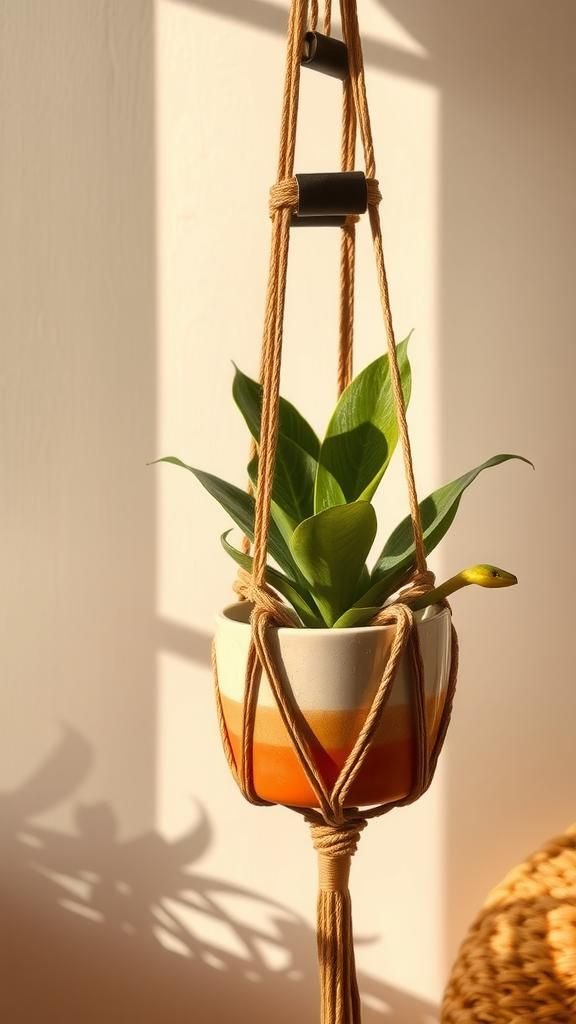
A strip of leather woven through the top creates a quiet contrast that feels unexpectedly refined against organic cord. The leather edge is cool and slightly smooth, and its darker hue brings depth to lighter fibers.
I appreciate the blend of textures when a terracotta pot sits inside; the leather seems to frame the planter like a picture. Over time the leather softens and acquires a faint patina, which adds character.
The combination reads as both structured and laid back, a small design punctuation that makes the hanger feel carefully considered.
Steps
- Cut a length of leather strip to thread through the hanger top and prepare cord bundle below it.
- Secure the leather by wrapping cords around it and tying a reinforcing knot so it stays centered.
- Continue the macrame pattern beneath the leather, ensuring cords pass evenly for balance.
- Finish the lower cradle with gathering knots sized for the chosen planter.
- Hang the piece and let the leather settle into a gentle curve under the pot’s weight.
Mini succulent cradle for tiny pots and vignettes
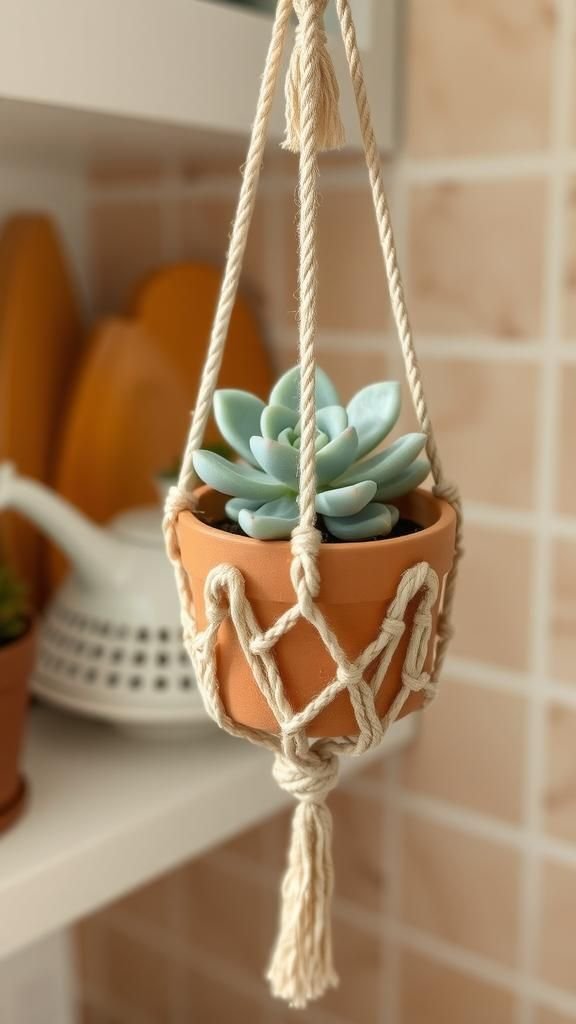
Small hangers made for succulents have an intimacy that larger pieces sometimes lack. The fine cords hug little terracotta cups and the miniature knots feel delicate between fingertips.
I like placing these in kitchen corners where they catch morning light and add a whisper of green. The compact size makes them easy to experiment with in clusters, and the tiny shadow they cast is charming.
The whole piece reads like a tiny pendant for plants, offering a focused moment of texture without claiming too much visual space.
Steps
- Measure and cut short cord lengths appropriate for a small succulent pot and secure them to a small ring.
- Create a snug base with tight knots to cradle the little pot securely without excess slack.
- Tie a finishing knot below the base and trim fringe to a tidy micro-tassel.
- Hang at eye level near a bright window and adjust knot tension so the pot sits stable.
- Group multiple mini hangers together for a charming clustered display.
Recycled fabric cord hanger with frayed edges
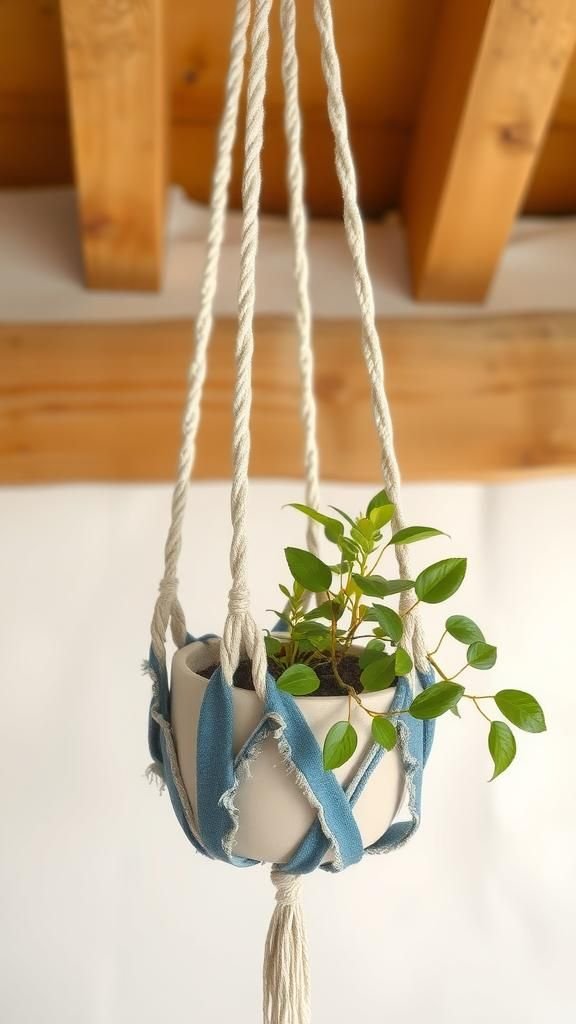
Working with strips of recycled fabric brings a scrappy, tactile energy to a hanger. The frayed edges carry a casual, lived-in look and the heavier weight of the material gives the piece a sturdier silhouette.
Different fabrics create a patchwork of textures that catch light in different ways, and I often enjoy the slight variation in tone where threads have faded. The hanger feels handmade in the most honest sense, with soft rattling from the fabric layers when a breeze moves through.
It adds a friendly, sustainable note to a green corner.
Steps
- Prepare fabric strips by tearing or cutting recycled textiles into even widths for cord substitution.
- Bundle the fabric strips and secure them to a ring or loop to form the hanger top.
- Weave or knot the strips into a supportive mesh cradle sized for the planter.
- Finish the base with a gathering knot and tidy frayed ends to maintain a cohesive look.
- Hang the piece and redistribute fabric strips so the planter sits centered and stable.
Jute rustic hanger for earthy bohemian corners
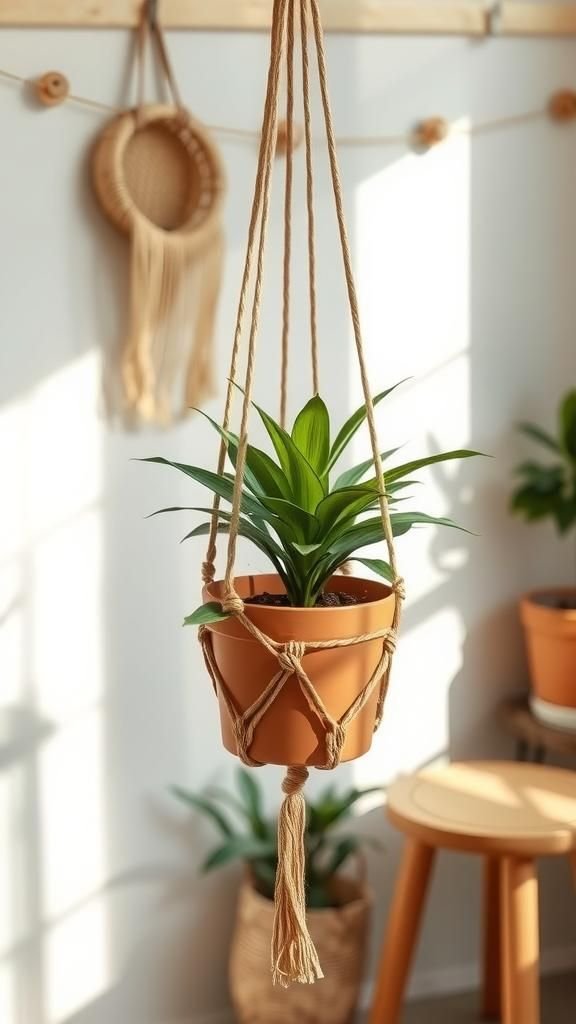
Jute has a pleasantly coarse grain that makes a hanger feel rooted and organic. The natural brown tones lend an earthy presence, and I appreciate how the fibers catch tiny speckles of sunlight.
Handling the jute feels grounding; it is slightly rougher than cotton and carries faint plant smells after a day in the sun. A jute hanger reads as warm and tactile, and it pairs especially well with clay planters and woven baskets.
The weight of the jute supports larger pots without looking heavy, giving an honest, rustic quality to a room.
Steps
- Cut strong lengths of jute cord and secure them to a sturdy metal or wooden ring for the hanger top.
- Create a supportive net using square or half hitch knots, sizing the pattern for the planter.
- Reinforce load-bearing sections with extra wraps or additional cords for durability.
- Gather the lower cords into a firm knot to cradle the planter and trim excess to form a neat fringe.
- Hang and check that the planter rests level and that jute wraps are snug without over-tightening.
Adjustable length hanger for flexible placement
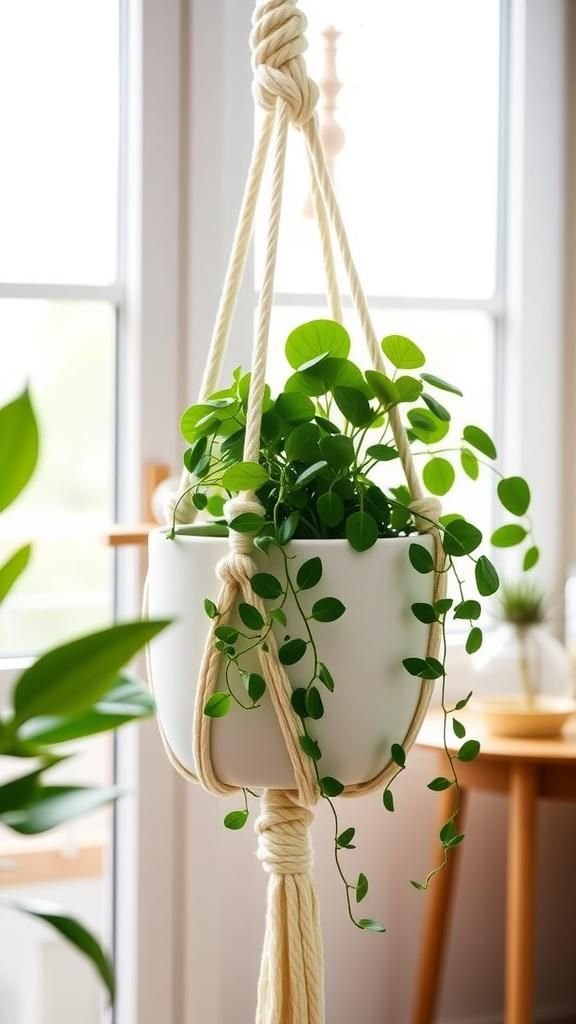
An adjustable hanger that lets me change the drop length feels very practical and oddly liberating. The mechanism often involves sliding knots that can be coaxed along to shorten or lengthen the hanger, and the tactile sensation of the cords moving under the fingers is satisfying.
This flexibility means a single hanger can adapt to different ceiling heights or room arrangements. I enjoy shifting the height to play with light on a plant throughout the day; it changes how leaves catch sparkle and cast shadows, making the plant feel alive in different ways.
Steps
- Prepare long cords and tie sliding knots near the top so the hanging length can be adjusted smoothly.
- Construct the main cradle below the sliding knobs using complementary knots sized for the planter.
- Test the sliding mechanism and adjust knot friction so it moves when pulled but holds when positioned.
- Secure the lower cradle with a gathering knot and trim any loose ends for a tidy look.
- Hang and practice adjusting the length to ensure the plant remains level at various heights.
Chunky cord statement piece for large planters
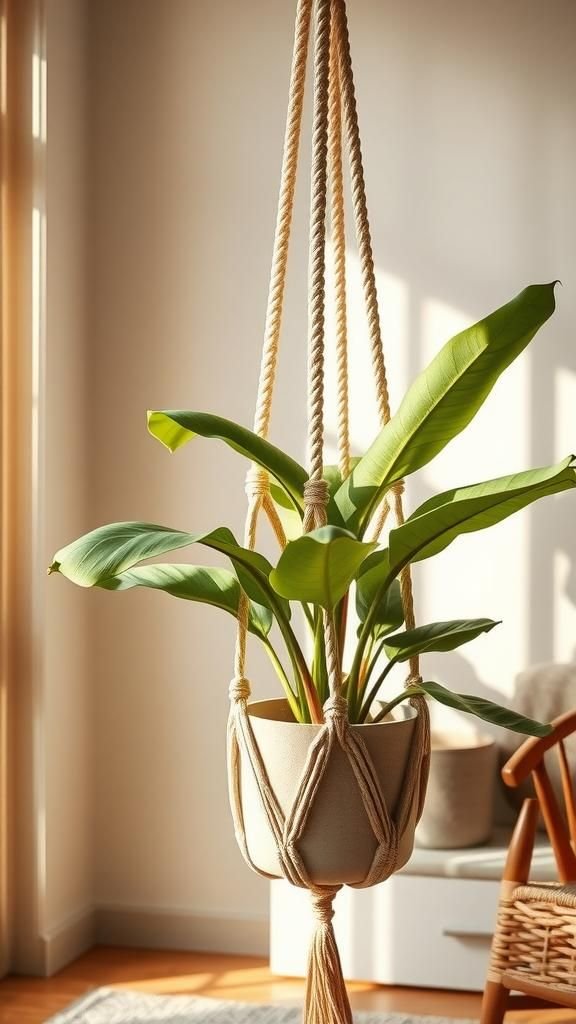
Using chunky cord turns a hanger into a bold sculptural object that anchors a room. The thick fibers have a pleasing weight and the knots read like heavy braids, giving an immediate sense of presence.
I recall how a wool-blend cord made a hanger feel like a suspended textile sculpture, and the planter within looked elevated as if floated on a hammock of rope. The tactile heft is satisfying in the hand, and the overall look suits a sunlit corner where the hanger can be admired from different angles.
Steps
- Select heavy gauge cord and cut substantial lengths to account for thicker knot sizes and overall length.
- Secure cords to a robust ring or beam point and plan a simple, strong knot pattern suitable for weight.
- Form wide, supportive knots to cradle the planter and reinforce stress points with extra wraps.
- Tie a secure gathering knot beneath the planter and trim or braid the remaining cord for visual interest.
- Ensure the mounting point is rated for the combined weight before suspending the chunky hanger.
Ladder-style macrame for cascading pot arrangement
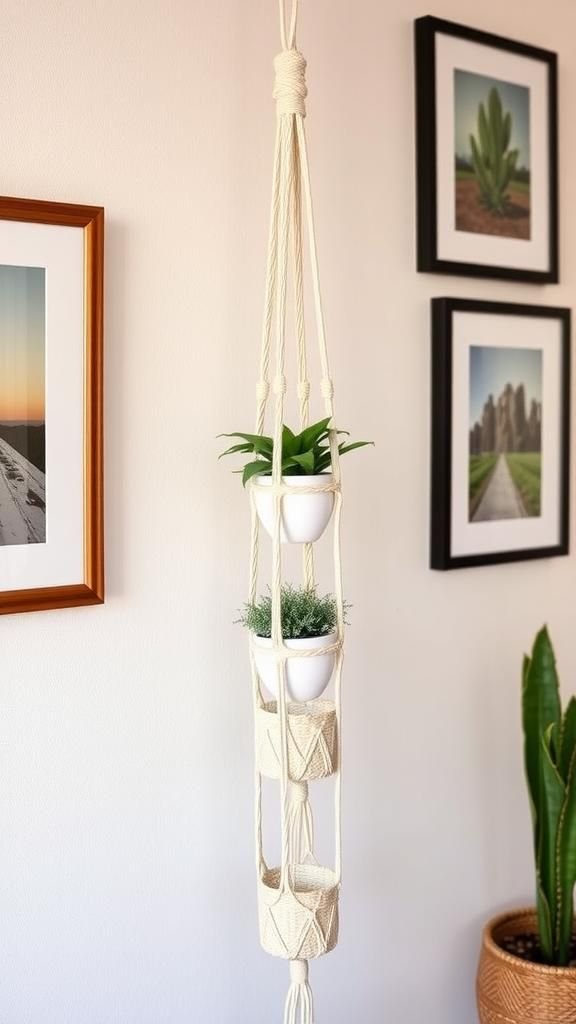
A ladder-style hanger creates a tiered effect that feels playful and structured at once. Each rung becomes a little stage for a pot, and I like how the eye moves along the vertical line from top to bottom.
The repetition of knots gives a rhythmic, almost musical quality when the piece shifts. The cords occasionally brush against each other making a soft, pleasant sound.
Placing different plants along the ladder produces a dynamic display of leaf shapes and colors that brightens a corner and invites closer, lingering looks.
Steps
- Construct two parallel cord lines and connect them at intervals with horizontal knots to form ladder rungs.
- Attach small cradles or platforms along selected rungs sized for each planter.
- Reinforce rung junctions with extra wraps to support planter weight safely.
- Secure top and bottom ends to keep the ladder taut and prevent slippage when hung.
- Arrange planters along the rungs and tweak spacing for a balanced visual flow.
Geometric diamond pattern for visual interest
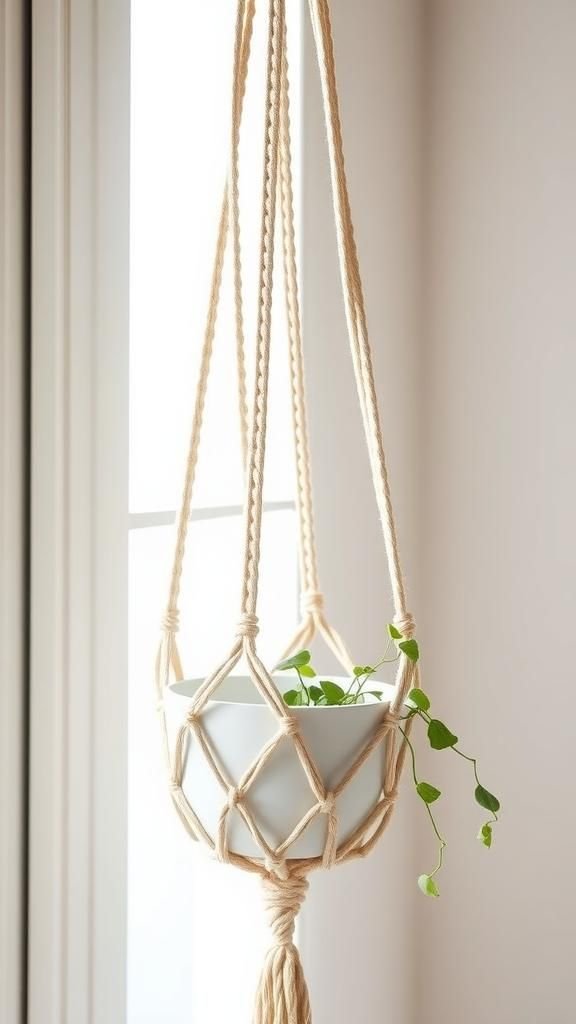
A repeating diamond motif adds a crisp geometry that catches the eye. The pattern plays with positive and negative space, and when sunlight filters through it the resulting shadows create a delicate lace on nearby surfaces.
I appreciate how the diamond grid frames a pot while still letting the planter be the focal point. The cords between diamond intersections have a slight springiness, and the tactile sensation of the knots feels pleasant under fingertips.
It makes a hanger feel thoughtful and a little architectural without being rigid.
Steps
- Divide cords into even groups and plan out diamond intersections in your knotting layout.
- Tie alternating square and diagonal knots to form the diamond lattice pattern around the planter area.
- Adjust knot spacing to ensure diamonds are uniform and support the pot evenly.
- Secure the lower edge with a gathering knot to form a stable cradle for the planter.
- Trim or style the remaining cords beneath the gathering knot to complement the diamond pattern.
Fringe cradle with boho festival energy
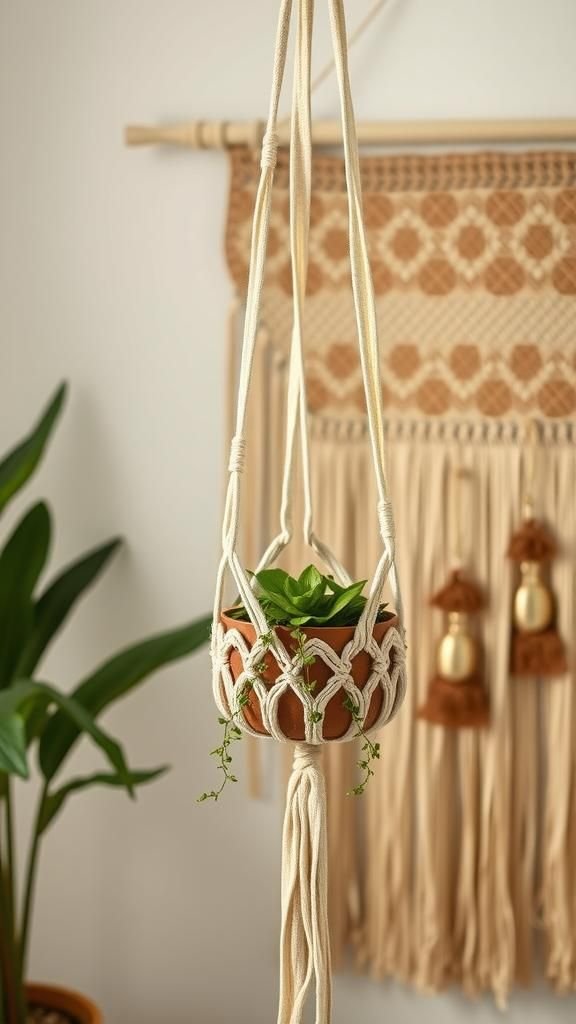
An exuberant fringe beneath a cradle gives a hanger a carefree, festival-like energy. The motion of the fringe is playful, and I often catch myself arranging strands so they fall just so.
The texture is tactile and a little wild, with ends that soften over time. When a planter sits above that fringe it feels like a little cloud of fibers, light and lively.
The overall effect adds a touch of whimsy to a room and pairs well with patterned textiles and layered rugs for a relaxed, creative corner.
Steps
- Weave the main macrame cradle and leave extended cord lengths below to form the fringe section.
- Group fringe strands into clusters and bind them with small wrapping knots to create volume.
- Fringe clusters can be brushed or combed gently to achieve a fluffy texture.
- Balance the fringe visually by trimming stray lengths to shape a pleasing silhouette.
- Hang the planter and let the fringe breathe with ambient air currents for natural movement.
Hanger with built-in drainage-friendly cradle

Designing a cradle that allows excess water to escape felt like a small practical triumph. The open-weave base lets air and moisture move freely, and I noticed plants seemed more content with that breathability.
The texture of the open net is airy and light, and small droplets sometimes catch on knot edges after a watering. There is a quiet feeling of well-being watching a pot sit secure yet ventilated, and the whole arrangement takes on a fresh, gardenerly charm.
The hanger reads as thoughtful and lived-in in a way I appreciate.
Steps
- Plan a looser knot pattern at the base of the cradle to allow space for water to drain freely.
- Create a sturdy rim of knots to support the planter while leaving the center more open.
- Reinforce load-bearing cords so the open weave remains stable when the pot is wet and heavy.
- Leave enough gap between knots for airflow and to prevent water pooling around the planter base.
- Hang and monitor how the cradle manages moisture, adjusting knot tension if needed for stability.
Boho chandelier planter for dramatic impact
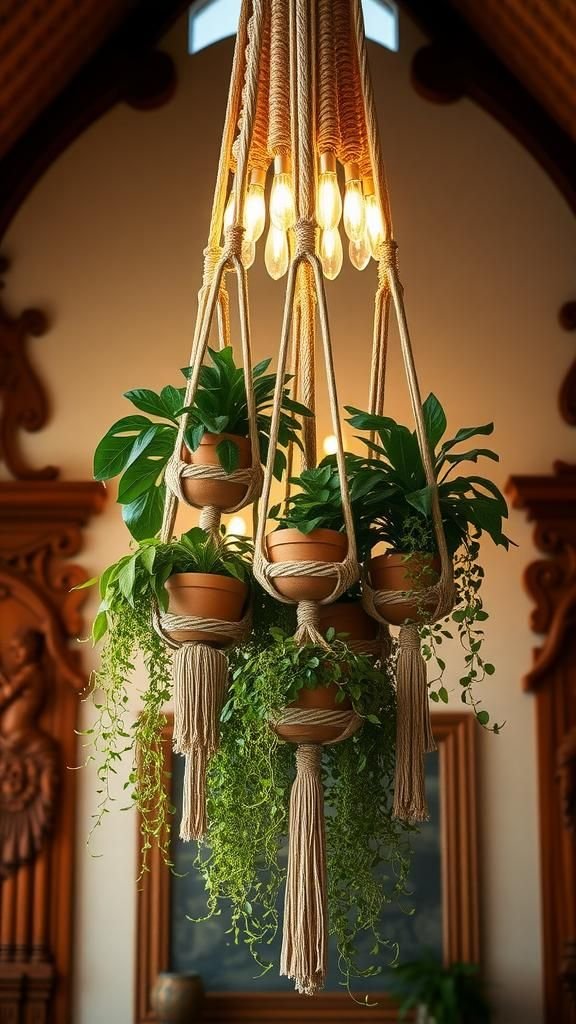
A chandelier-style hanger turns plants into a suspended centerpiece that draws attention. Multiple arms of cord radiate like a textile chandelier, and the piece casts intricate shadows across ceilings and floors.
I remember the first time I stepped under one and felt like the room gained a gentle, living canopy. The cords have a soft give and the overall structure feels surprisingly airy despite its complexity.
This approach suits a bright entryway or tall living room where the vertical drama can be fully appreciated and leaves can tumble down in soft cascades.
Steps
- Create multiple hanging arms by securing several bundles of cords to a central hoop or ring.
- Weave individual cradles or small planters on each arm, spacing them to form a balanced chandelier silhouette.
- Reinforce the central ring with extra wraps and cross ties to distribute weight evenly.
- Add decorative elements like tassels or beads to each arm for cohesion and texture.
- Hang from a robust ceiling hook rated for the combined weight and adjust arm lengths for a pleasing arrangement.